Closing the nuclear cycle in Italy
Nucleco has worked for many years in decommissioning nuclear power plants and facilities managed by Sogin.
The Company has carried out important work in developing appropriate intervention methods for each of the plant technologies present in Italy.
Caorso (PC) nuclear power plant
BWR, Boiling Water Reactor, 860 MWe

The largest Italian plant – it belongs to the second generation of nuclear plants and was in operation from 1981 to 1986.
Nucleco began work at this plant immediately after it was shut down, coordinating, from 1986 to 1988, activities for the pilot incineration campaign (in Belgium and Sweden) of low level waste and the qualification of the ash conditioning process.
In the early ’90s, it undertook a campaign for the supercompaction of over 2,300 drums with low-level technological waste. Subsequently, on behalf of Sogin, Nucleco worked on the decontamination of the primary circuit and the dismantling and decontamination of materials and metal components from the turbine building and the supercompaction of drums.
In 2015, it carried out the decontamination and characterization of the vapour suppression pool.
Garigliano (CE) nuclear power plant
BWR, Boiling Water Reactor, 160 MW
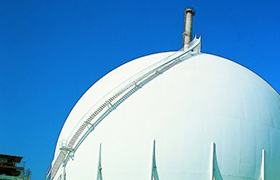
A first-generation power plant that started operating in 1964 and closed in 1982.
In the mid ’80s, Nucleco oversaw the design of the GECO plant for the solidification of liquid radioactive waste and subsequently, from 1996 to 1999, carried out the campaign for the solidification of resins, sludge and concentrates, producing over 1,700 products suitable for final disposal.
More recently, Nucleco undertook asbestos removal operations in the reactor building and the related campaign to supercompact drums containing contaminated materials.
In addition, Nucleco performed the remediation of trenches 2 and 3 and proceeded to recover previously buried radioactive waste.
Latina nuclear power plant
Gas-Graphite, 210 MW

A GCR-Magnox plant that started operating in 1963 and closed in 1987.
In the mid-80s, Nucleco carried out a pilot campaign to extract waste from the “splitter tanks”: In 2000, the Company then carried our the supercompaction campaign, with a mobile press, of over 1600 drums containing technological waste.
Since 2015, Nucleco has been responsible for the executive design of a plant for the extraction, sorting and radiological characterization of Magnox residues; the planning and implementation of activities for the treatment of rock wool from insulation removal from the primary circuit, the radiological characterization of radioactive waste produced by the power plant and the planning and implementation of a campaign for the recovery of KCFC filters.
Trino (VC) nuclear power plant
PWR, Pressurized Water Reactor, 270 MW
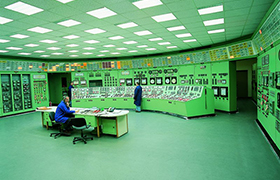
Construction began in 1961, it became operational in October 1964 and closed in 1987.
Since 1993, Nucleco has carried out, first for Enel and then for Sogin, a supercompaction campaign with a mobile press of over 1600 drums containing technological waste.
A subsequent supercompaction campaign was carried out in 2013-14 and the drums were transferred to the Casaccia plant.
In 2014, it undertook the remediation of asbestos from the reactor head, in addition to the packaging, processing and characterization of past radioactive waste.
Saluggia (VC) EUREX plant
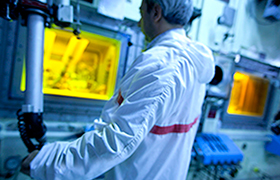
The EUREX (Enriched Uranium Extraction) plant began operation in 1970. ENEA carried out research at the plant into the reprocessing of irradiated fuel in order to separate and recover reusable nuclear material (uranium and plutonium).
Between 1988 and 1995, Nucleco dismantled, on behalf of ENEA, the technological systems of the Plant Manufacturing Fuel Elements (IFEC) and carried out a campaign of supercompaction of over 3000 radioactive waste drums at the site.
In the 2011-2015 period, Nucleco conducted the preliminary characterization, treatment and conditioning of waste produced from the remediation of the EUREX pool and from the dismantling of the IFEC plant.
Rotondella (MT) ITREC plant
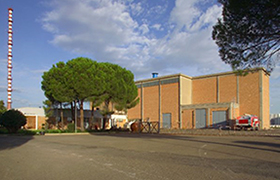
The ITREC plant, a plant for the retreatment and remanufacturing of fuel, was built between 1965-1970 by the CNEN (National Committee for Nuclear Energy) to carry out research into retreatment and remanufacturing processes for the uranium-thorium cycle.
In the ’80s-’90s, Nucleco carried out campaigns for the remediation of trenches for the recovery of buried radioactive waste and supercompaction of technological waste (for over 4800 drums). It also carried out two campaigns of cementicious matrix conditioning of liquid waste.
Between 2009 and 2011, Nucleco created and operated the SIRIS plant for the characterization, treatment and conditioning of solid waste.
It is involved in the executive planning and implementation of the remediation of trench 7.1 for the recovery of a reinforced concrete monolith containing high-activity waste.
Bosco Marengo (AL) FN plant
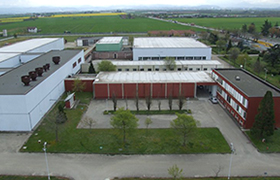
The FN plant, built in the early seventies by “Fabbricazioni Nucleari” (Ansaldo Meccanico Nucleare and General Electric), started operations in 1973.
In the mid-90s, Nucleco carried out its first supercompaction campaign, processing over 2600 drums. More recently, it has undertaken asbestos remediation and radioactive waste repackaging operations.
Casaccia (RM) OPEC and IPU plants
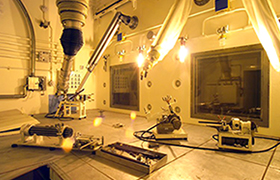
The following are located within the Enea Research Centre in Casaccia: the OPErazioni Celle Calde (OPEC - Hot Cell Operations) plant consists of two systems, named OPEC1 and OPEC2, where research into nuclear fuel elements is carried out (UO2).
The Plutonium (IPU) plant was dedicated to research into technology for nuclear fuel production using mixed uranium and plutonium oxides.
Nucleco is involved in the decontamination and remediation of the Hot Cells of the OPEC1 plant, in the dismantling of the Glove Boxes (SAG) in the IPU plant and in the dismantling and remediation of the underground tanks for liquid waste collection (Waste A&B).